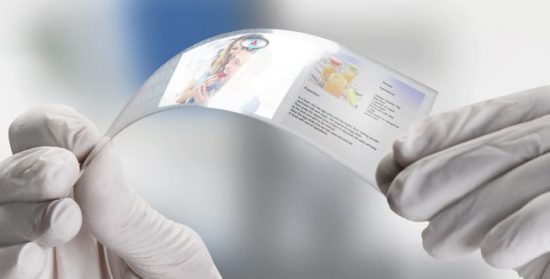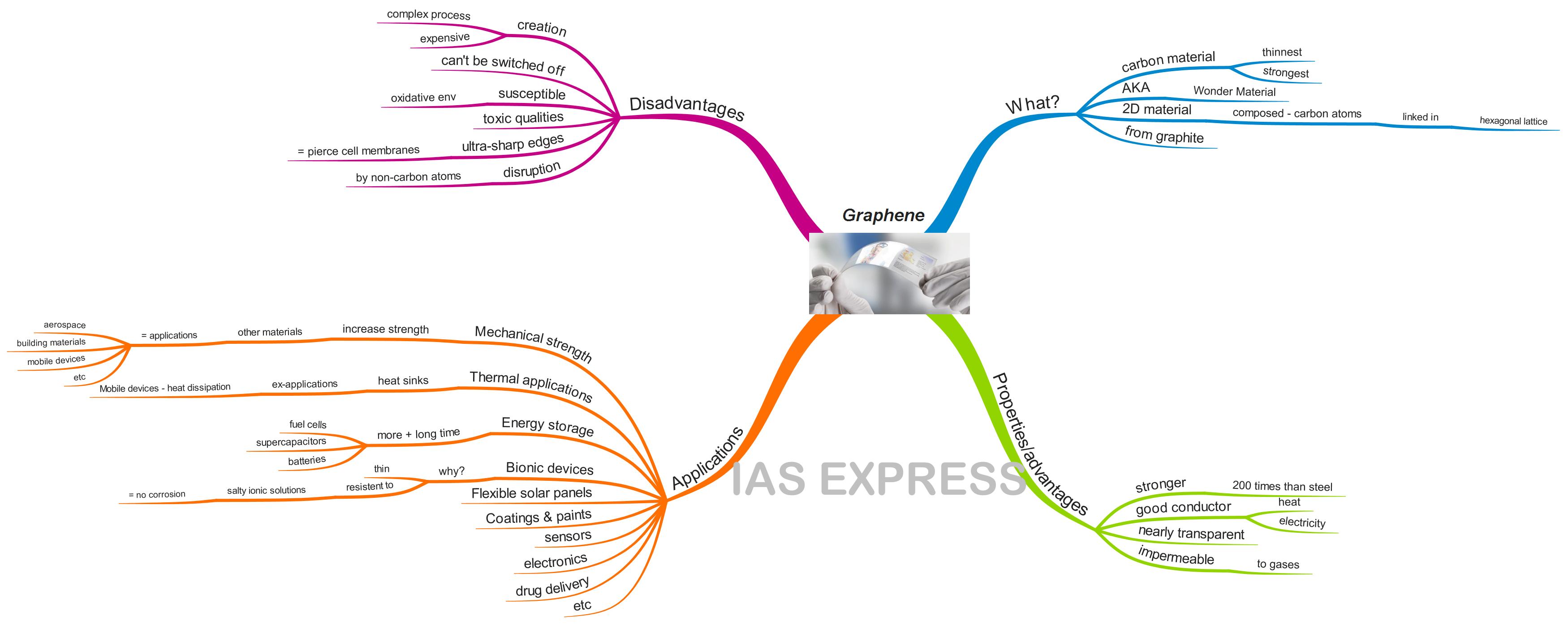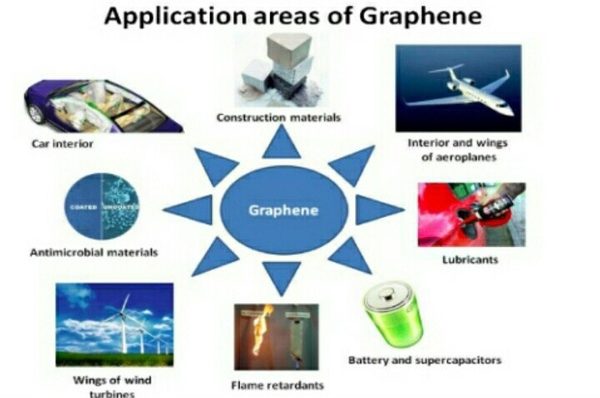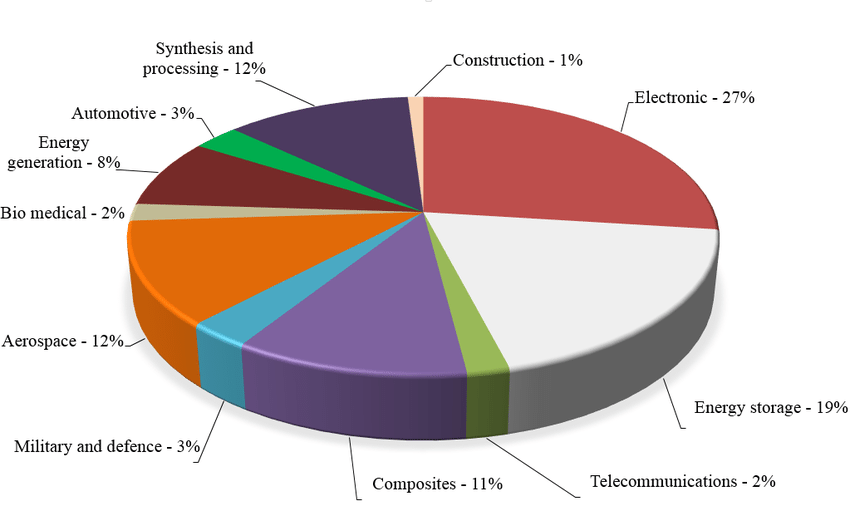Graphene: Applications, Advantages, Disadvantages

The growing popularity of digital devices has increased the need for integrated circuits that are light weight, utilize ultra-low power and are highly efficient. Technology firms are increasingly focusing on nano electronics particularly graphene for manufacturing such devices.
This topic of “Graphene: Applications, Advantages, Disadvantages” is important from the perspective of the UPSC IAS Examination, which falls under General Studies Portion.
What is Graphene?
- Graphene, a carbon material, is the thinnest and strongest material known. It is also known as “The Wonder Material”.
- It is a two-dimensional (2D) material composed of carbon atoms linked in a hexagonal lattice.
- It is extracted from graphite. Graphite is arranged in 3D crystalline manner, whereas, graphene is a 2D crystal only an atom thick.
- It came into the limelight after its exceptional quantum properties fetched Andre Geim and Konstantin Novoselov the 2010 Nobel Prize in Physics. Since then, many research projects have focussed on its applications in nano electronics.
What are its properties? (Advantages)
- It is about 200 times stronger than steel.
- It is a better conductor of electricity & heat compared to copper.
- It is nearly transparent.
- It is impermeable to gases.
All these properties are exciting researchers and businesses around the world – as graphene has the potential to revolutionize entire industries – in the fields of electricity, conductivity, energy generation, batteries, sensors and more.
What are the applications of Graphene?
Mechanical strength
- Graphene is the world’s strongest material, and hence can be utilised to increase the strength of other materials.
- Several researches have demonstrated that adding even a trace amount of graphene to plastics, metals or other materials can make these materials much stronger – or lighter (as you can use less amount of material to achieve the same strength).
- Such graphene-enhanced composite materials can find applications in aerospace, building materials, mobile devices, and many other applications.
Thermal applications
- Graphene is the world’s most conductive material to heat + it is also strong and light, which means that it is a great material to make heat-spreading solutions, such as heat sinks (a device or substance for absorbing excessive or unwanted heat).
- This could be applicable in both microelectronics (ex- making LED lighting more efficient and longer lasting) and also in larger applications (Ex- thermal foils for mobile devices to dissipate heat).
Energy storage
- Graphene is the world’s thinnest material and it also has the highest surface-area to volume ratio. This makes graphene a very promising material to be utilized in batteries and supercapacitors.
- Thus Graphene may enable devices that can store more energy for long time and charge faster, too.
- Graphene can also be used to enhance fuel-cells.
Bionic devices
- Because graphene is thin and flexible, it could be integrated into “bionic” devices that would be implanted in living tissue.
- The term “bionic”—a mix of “biology” and “electronic”—refers to devices that help or improve an organ or tissue, such as artificial hearts or cochlear implants, which assist people with hearing loss.
- Graphene is resistant to the salty ionic solutions inside living tissue, so bionic devices made of graphene could have long shelf lives, perhaps lasting a lifetime. This is in contrast to metallic parts that can corrode after a few years, possibly releasing toxic metals into the body.
Flexible solar panels
- Graphene has sparked the interest of engineers who are trying to make new, lightweight, and flexible solar panels that could be used to cover the outside surface of a building, in addition to the roof—which is already being used.
- Graphene is nearly transparent to light—not only to visible light but also to other forms of electromagnetic radiation, including ultraviolet and infrared light.
- Graphene absorbs only 2% of the light falling on it, whether it is ultraviolet, infrared, or all of the wavelengths in between.
- Combine this with graphene’s ability to conduct electricity, and you have very efficient, electrical conductors that are transparent, thin, flexible, and cheap.
Coatings, sensors, electronics and more
- Graphene has a lot of other promising applications: anti-corrosion coatings and paints, efficient and precise sensors, faster and efficient electronics, flexible displays, faster DNA sequencing, drug delivery, and more.
- It has to be noted that, the world’s thinnest light bulb created from Graphene.
Therefore, Graphene is such a great and basic building block that it seems that any industry can benefit from this new material.
What are the disadvantages of Graphene?
- Creation of high quality graphene is expensive and complex process.
- Being a great conductor of electricity, graphene cannot be switched off. Scientists are working on rectifying this.
- The main disadvantage of graphene as a catalyst is its susceptibility to oxidative environments.
- In order to grow graphene, toxic chemicals are being used at high temperatures. Due to this it exhibits some toxic qualities.
- Scientists discovered that graphene features ultra-sharp edges that can easily pierce cell membranes, allowing it to enter into the cell and disrupt normal functions.
- One of the obstacles that needs to be overcome is how to make sheets of
graphene large enough and pure enough to be useful. Any non-carbon
atoms can disrupt the perfect hexagonal pattern for graphene.
These are just but a few of the ‘wonder material’s’ advantages and disadvantages and since the material is still in the research stage much more is yet to be revealed.




